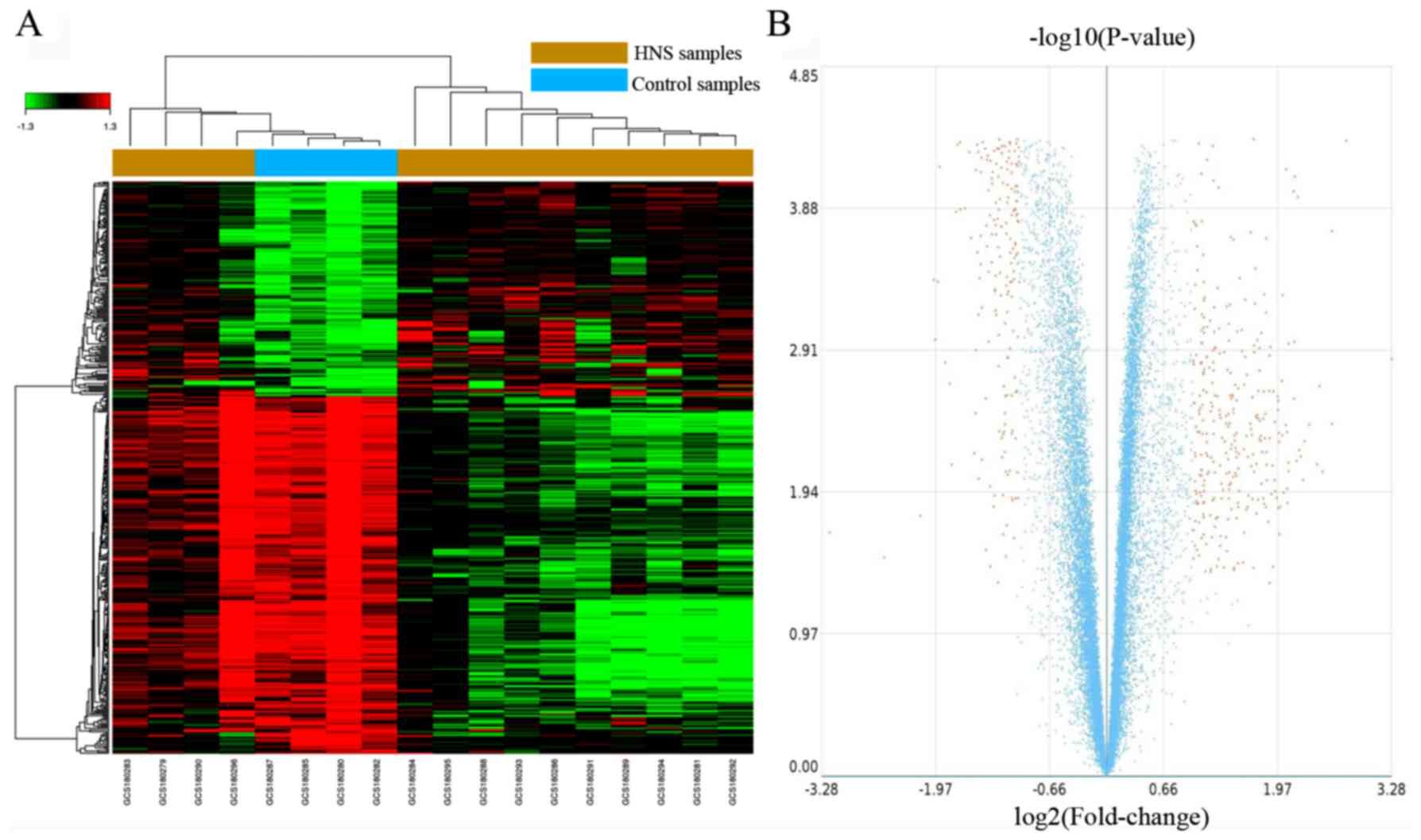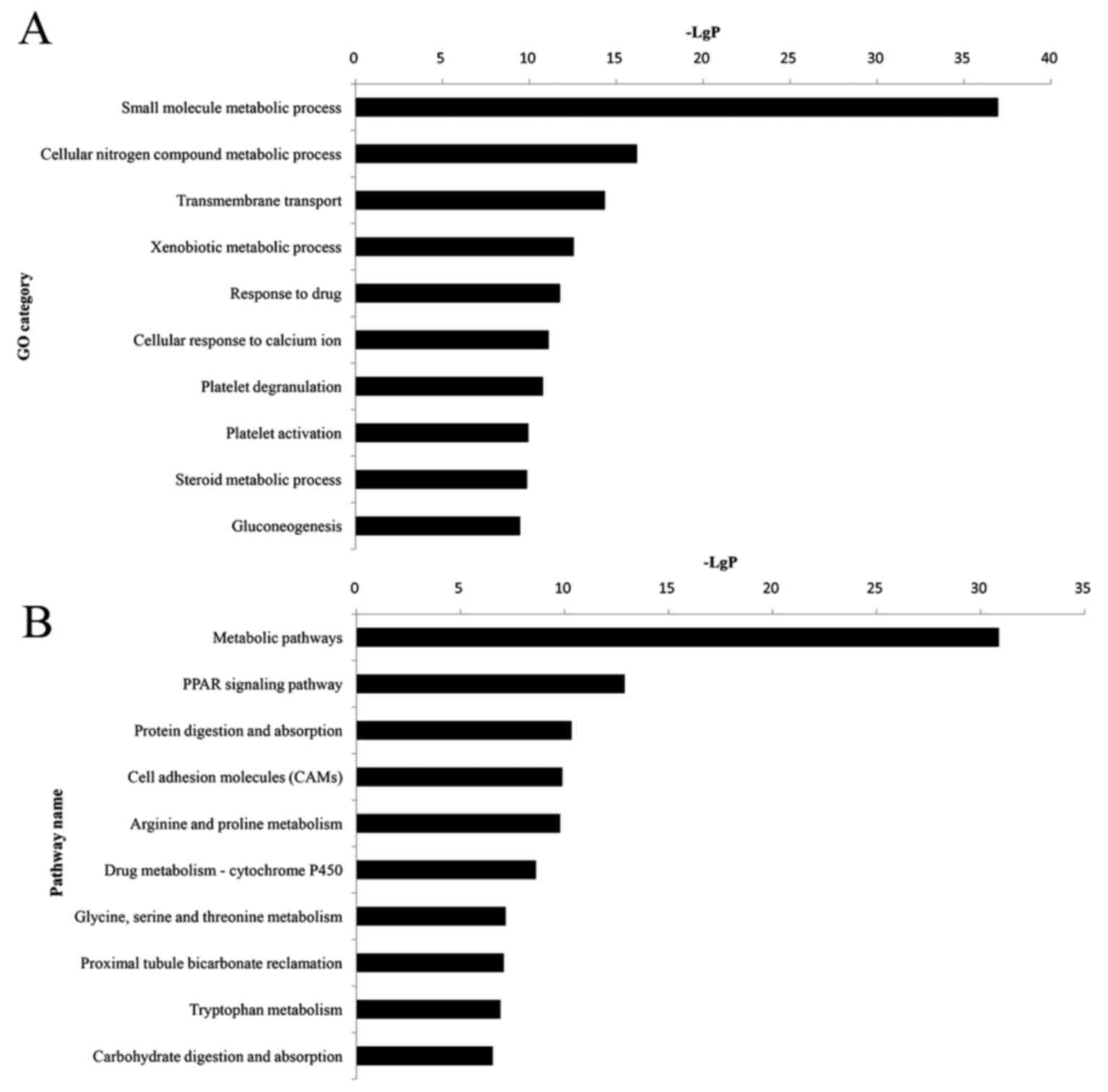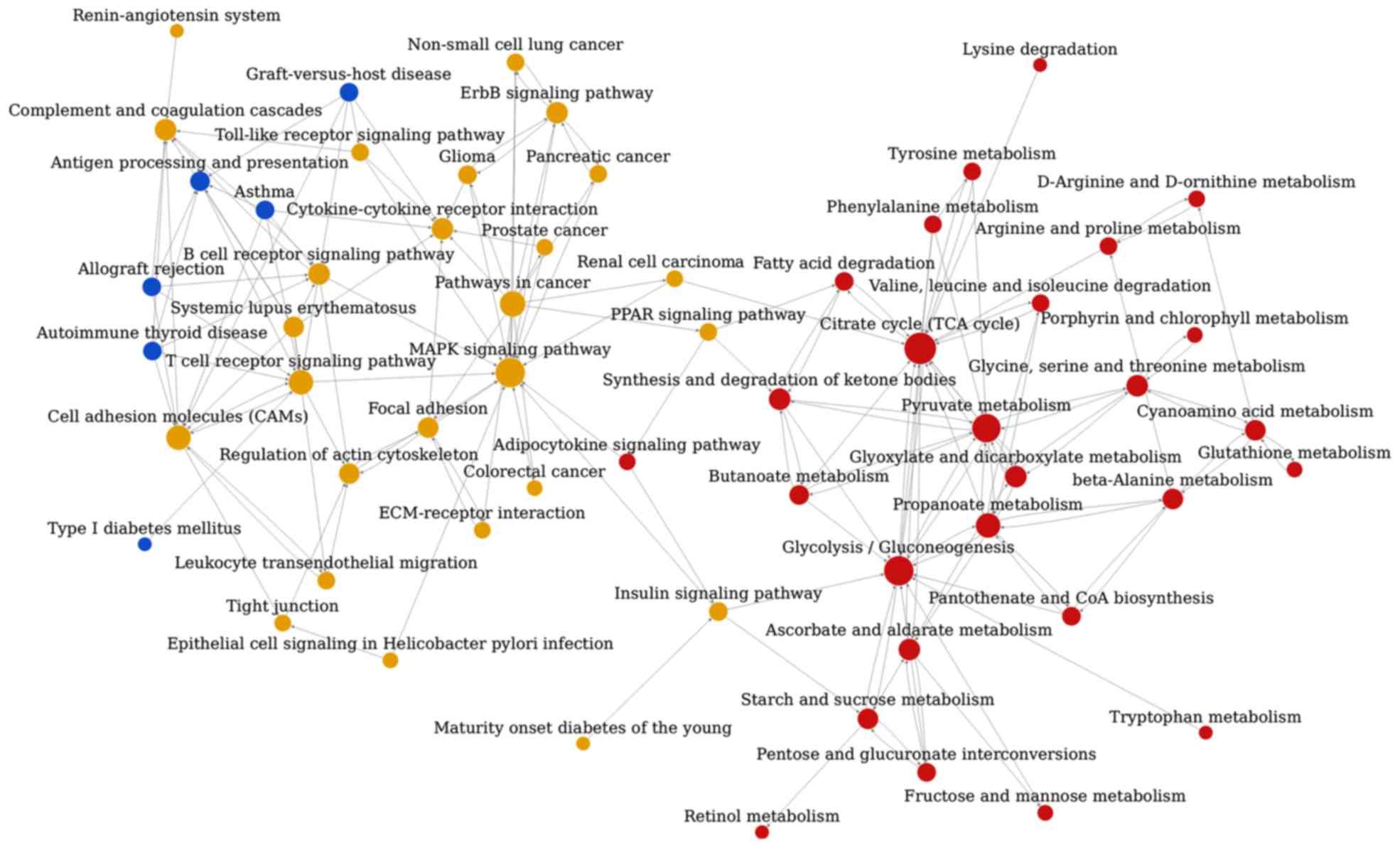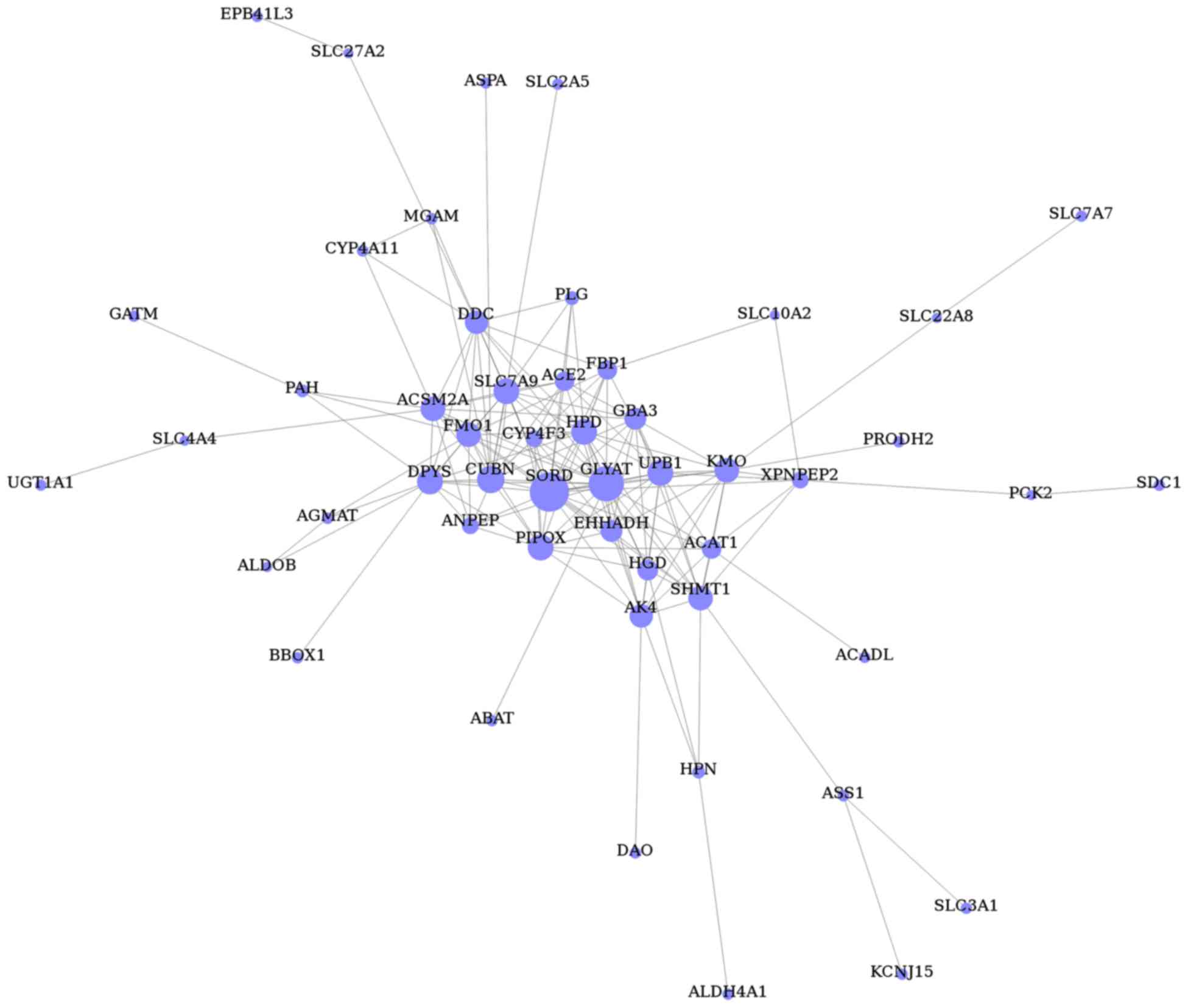|
1
|
Muta K, Obata Y, Oka S, Abe S, Minami K,
Kitamura M, Endo D, Koji T and Nishino T: Curcumin ameliorates
nephrosclerosis via suppression of histone acetylation independent
of hypertension. Nephrol Dial Transplant. 31:1615–1623. 2016.
View Article : Google Scholar : PubMed/NCBI
|
|
2
|
Meyrier A: Nephrosclerosis: Update on a
centenarian. Nephrol Dial Transplant. 30:1833–1841. 2015.
View Article : Google Scholar : PubMed/NCBI
|
|
3
|
Hughson MD, Puelles VG, Hoy WE,
Douglas-Denton RN, Mott SA and Bertram JF: Hypertension, glomerular
hypertrophy and nephrosclerosis: The effect of race. Nephrol Dial
Transplant. 29:1399–1409. 2014. View Article : Google Scholar : PubMed/NCBI
|
|
4
|
Murea M and Freedman BI: Essential
hypertension and risk of nephropathy: A reappraisal. Curr Opin
Nephrol Hypertens. 19:235–241. 2010. View Article : Google Scholar : PubMed/NCBI
|
|
5
|
Liang S, Le W, Liang D, Chen H, Xu F, Chen
H, Liu Z and Zeng C: Clinico-pathological characteristics and
outcomes of patients with biopsy-proven hypertensive
nephrosclerosis: A retrospective cohort study. Bmc Nephrol.
17:422016. View Article : Google Scholar : PubMed/NCBI
|
|
6
|
Lv Y, Que Y, Su Q, Li Q, Chen X and Lu H:
Bioinformatics facilitating the use of microarrays to delineate
potential miRNA biomarkers in aristolochic acid nephropathy.
Oncotarget. 7:52270–52280. 2016. View Article : Google Scholar : PubMed/NCBI
|
|
7
|
Zhao YY: Metabolomics in chronic kidney
disease. Clin Chim Acta. 422:59–69. 2013. View Article : Google Scholar : PubMed/NCBI
|
|
8
|
Papadopoulos T, Krochmal M, Cisek K,
Fernandes M, Husi H, Stevens R, Bascands J, Schanstra JP and Klein
J: Omics databases on kidney disease: Where they can be found and
how to benefit from them. Clin Kidney J. 9:343–352. 2016.
View Article : Google Scholar : PubMed/NCBI
|
|
9
|
Liang B, Li C and Zhao J: Identification
of key pathways and genes in colorectal cancer using bioinformatics
analysis. Med Oncol. 33:1112016. View Article : Google Scholar : PubMed/NCBI
|
|
10
|
Berthier CC, Bethunaickan R,
Gonzalez-Rivera T, Nair V, Ramanujam M, Zhang W, Bottinger EP,
Segerer S, Lindenmeyer M, Cohen CD, et al: Cross-species
transcriptional network analysis defines shared inflammatory
responses in murine and human lupus nephritis. J Immunol.
189:988–1001. 2012. View Article : Google Scholar : PubMed/NCBI
|
|
11
|
Hauser PV, Perco P, Mühlberger I, Pippin
J, Blonski M, Mayer B, Alpers CE, Oberbauer R and Shankland SJ:
Microarray and bioinformatics analysis of gene expression in
experimental membranous nephropathy. Nephron Exp Nephrol.
112:e43–e58. 2009. View Article : Google Scholar : PubMed/NCBI
|
|
12
|
Eissa S, Matboli M and Bekhet MM: Clinical
verification of a novel urinary microRNA panal: 133b, −342 and −30
as biomarkers for diabetic nephropathy identified by bioinformatics
analysis. Biomed Pharmacother. 83:92–99. 2016. View Article : Google Scholar : PubMed/NCBI
|
|
13
|
Neusser MA, Lindenmeyer MT, Moll AG,
Segerer S, Edenhofer I, Sen K, Stiehl DP, Kretzler M, Gröne H,
Schlöndorff D and Cohen CD: Human nephrosclerosis triggers a
hypoxia-related glomerulopathy. Am J Pathol. 176:594–607. 2010.
View Article : Google Scholar : PubMed/NCBI
|
|
14
|
Marcantoni C and Fogo AB: A perspective on
arterionephrosclerosis: From pathology to potential pathogenesis. J
Nephrol. 20:518–524. 2007.PubMed/NCBI
|
|
15
|
Fogo A, Breyer JA, Smith MC, Cleveland WH,
Agodoa L, Kirk KA and Glassock R: Accuracy of the diagnosis of
hypertensive nephrosclerosis in African Americans: A report from
the African American study of kidney disease (AASK) Trial. AASK
pilot study investigators. Kidney Int. 51:244–252. 1997. View Article : Google Scholar : PubMed/NCBI
|
|
16
|
Schlessinger SD, Tankersley MR and Curtis
JJ: Clinical documentation of end-stage renal disease due to
hypertension. Am J Kidney Dis. 23:655–660. 1994. View Article : Google Scholar : PubMed/NCBI
|
|
17
|
Bolstad BM: Low-level analysis of
high-density oligonucleotide array data: Background, normalization
and summarization. unpublished PhD thesisUniversity of California
Berkeley: 2004
|
|
18
|
Benjamini Y and Hochberg Y: Controlling
the false discovery rate: A practical and powerful approach to
multiple testing. J Royal Stat Soc Series B (Methodological).
57:289–300. 1995.
|
|
19
|
Yang Y, Kai G, Pu XD, Qing K, Guo XR and
Zhou XY: Expression profile of microRNAs in fetal lung development
of Sprague-Dawley rats. Int J Mol Med. 29:393–402. 2012.PubMed/NCBI
|
|
20
|
Eisen MB, Spellman PT, Brown PO and
Botstein D: Cluster analysis and display of genome-wide expression
patterns. Proc Natl Acad Sci USA. 95:pp. 14863–14868. 1998;
View Article : Google Scholar : PubMed/NCBI
|
|
21
|
Ashburner M, Ball CA, Blake JA, Botstein
D, Butler H, Cherry JM, Davis AP, Dolinski K, Dwight SS, Eppig JT,
et al: Gene ontology: Tool for the unification of biology. The gene
ontology consortium. Nat Genet. 25:25–29. 2000. View Article : Google Scholar : PubMed/NCBI
|
|
22
|
Kanehisa M and Goto S: KEGG: Kyoto
encyclopedia of genes and genomes. Nucleic Acids Res. 28:27–30.
2000. View Article : Google Scholar : PubMed/NCBI
|
|
23
|
Dennis G Jr, Sherman BT, Hosack DA, Yang
J, Gao W, Lane HC and Lempicki RA: DAVID: Database for annotation,
visualization, and integrated discovery. Genome Biol. 4:P32003.
View Article : Google Scholar : PubMed/NCBI
|
|
24
|
Langfelder P, Mischel PS and Horvath S:
When is hub gene selection better than standard meta-analysis? PLoS
One. 8:e615052013. View Article : Google Scholar : PubMed/NCBI
|
|
25
|
Sun Y, Yu B, Zhang K, Chen X and Chen D:
Paradigm of time-sequence development of the intestine of suckling
piglets with microarray. Asian-Australas J Anim Sci. 25:1481–1492.
2012. View Article : Google Scholar : PubMed/NCBI
|
|
26
|
Wei Z and Li H: A Markov random field
model for network-based analysis of genomic data. Bioinformatics.
23:1537–1544. 2007. View Article : Google Scholar : PubMed/NCBI
|
|
27
|
Zhao YY, Cheng XL, Lin RC and Wei F:
Lipidomics applications for disease biomarker discovery in mammal
models. Biomark Med. 9:153–168. 2015. View Article : Google Scholar : PubMed/NCBI
|
|
28
|
Schreiner GF: Renal toxicity of albumin
and other lipoproteins. Curr Opin Nephrol Hypertens. 4:369–373.
1995. View Article : Google Scholar : PubMed/NCBI
|
|
29
|
Gupta K, Iskandar SS, Daeihagh P, Ratliff
HL and Bleyer AJ: Distribution of pathologic findings in
individuals with nephrotic proteinuria according to serum albumin.
Nephrol Dial Transplant. 23:1595–1599. 2008. View Article : Google Scholar : PubMed/NCBI
|
|
30
|
Jarad G, Knutsen RH, Mecham RP and Miner
JH: Albumin contributes to kidney disease progression in Alport
syndrome. Am J Physiol Renal Physiol. 311:F120–F130. 2016.
View Article : Google Scholar : PubMed/NCBI
|
|
31
|
Zhang J, Jiang H and Chen J: Combined
effect of body mass index and metabolic status on the risk of
prevalent and incident chronic kidney disease: A systematic review
and meta-analysis. Oncotarget. 8:35619–35629. 2017.PubMed/NCBI
|
|
32
|
Issemann I and Green S: Activation of a
member of the steroid hormone receptor superfamily by peroxisome
proliferators. Nature. 347:645–650. 1990. View Article : Google Scholar : PubMed/NCBI
|
|
33
|
Jiang L, Chen XP, Long YB, Lei FY, Zhou
ZQ, Qin YH, Huang WF and Zhou TB: The potential signaling pathway
between peroxisome proliferator-activated receptor gamma and
retinoic acid receptor alpha in renal interstitial fibrosis
disease. J Recept Signal Transduct Res. 35:258–268. 2015.
View Article : Google Scholar : PubMed/NCBI
|
|
34
|
Hou X, Shen YH, Li C, Wang F, Zhang C, Bu
P and Zhang Y: PPARalpha agonist fenofibrate protects the kidney
from hypertensive injury in spontaneously hypertensive rats via
inhibition of oxidative stress and MAPK activity. Biochem Biophys
Res Commun. 394:653–659. 2010. View Article : Google Scholar : PubMed/NCBI
|
|
35
|
Su M, Dhoopun AR, Yuan Y, Huang S, Zhu C,
Ding G, Liu B, Yang T and Zhang A: Mitochondrial dysfunction is an
early event in aldosterone-induced podocyte injury. Am J Physiol
Renal Physiol. 305:F520–F531. 2013. View Article : Google Scholar : PubMed/NCBI
|
|
36
|
Martin-Lorenzo M, Martinez PJ,
Baldan-Martin M, Ruiz-Hurtado G, Prado JC, Segura J, de la Cuesta
F, Barderas MG, Vivanco F, Ruilope LM and Alvarez-Llamas G: Citric
acid metabolism in resistant hypertension: Underlying mechanisms
and metabolic prediction of treatment response. Hypertension.
70:1049–1056. 2017. View Article : Google Scholar : PubMed/NCBI
|
|
37
|
Hallan S, Afkarian M, Zelnick LR,
Kestenbaum B, Sharma S, Saito R, Darshi M, Barding G, Raftery D, Ju
W, et al: Metabolomics and gene expression analysis reveal
down-regulation of the citric acid (TCA) Cycle in non-diabetic CKD
patients. EBioMedicine. Oct 31–2017.(Epub ahead of print).
View Article : Google Scholar : PubMed/NCBI
|
|
38
|
Gao S, Chen W, Peng Z, Li N, Su L, Lv D,
Li L, Lin Q, Dong X, Guo Z and Lou Z: Urinary metabonomics
elucidate the therapeutic mechanism of Orthosiphon stamineus in
mouse crystal-induced kidney injury. J Ethnopharmacol. 166:323–332.
2015. View Article : Google Scholar : PubMed/NCBI
|
|
39
|
Beale EG, Harvey BJ and Forest C: PCK1 and
PCK2 as candidate diabetes and obesity genes. Cell Biochem Biophys.
48:89–95. 2007. View Article : Google Scholar : PubMed/NCBI
|
|
40
|
Zhang ZB, Zhang W, Li RL, Li JB, Zhong JF,
Zhao ZS and Huang JM: Novel splice variants of the bovine PCK1
gene. Genet Mol Res. 12:4028–4035. 2013. View Article : Google Scholar : PubMed/NCBI
|
|
41
|
Chakravarty K, Cassuto H, Reshef L and
Hanson RW: Factors that control the tissue-specific transcription
of the gene for phosphoenolpyruvate carboxykinase-C. Crit Rev
Biochem Mol Biol. 40:129–154. 2005. View Article : Google Scholar : PubMed/NCBI
|
|
42
|
Semakova J, Hyroššová P, Méndez-Lucas A,
Cutz E, Bermudez J, Burgess S, Alcántara S and Perales JC: PEPCK-C
reexpression in the liver counters neonatal hypoglycemia in Pck1
del/del mice, unmasking role in non-gluconeogenic tissues. J
Physiol Biochem. 73:89–98. 2017. View Article : Google Scholar : PubMed/NCBI
|
|
43
|
Brito MN, Brito NA, Brito SR, Moura MA,
Kawashita NH, Kettelhut IC and Migliorini RH: Brown adipose tissue
triacylglycerol synthesis in rats adapted to a high-protein,
carbohydrate-free diet. Am J Physiol. 276:R1003–R1009.
1999.PubMed/NCBI
|
|
44
|
Iwata T, Popescu NC, Zimonjic DB, Karlsson
C, Höög JO, Vaca G, Rodriguez IR and Carper D: Structural
organization of the human sorbitol dehydrogenase gene (SORD).
Genomics. 26:55–62. 1995. View Article : Google Scholar : PubMed/NCBI
|
|
45
|
Carr IM and Markham AF: Molecular genetic
analysis of the human sorbitol dehydrogenase gene. Mamm Genome.
6:645–652. 1995. View Article : Google Scholar : PubMed/NCBI
|
|
46
|
Obrosova IG, Ilnytska O, Lyzogubov VV,
Pavlov IA, Mashtalir N, Nadler JL and Drel VR: High-fat diet
induced neuropathy of pre-diabetes and obesity: Effects of
‘healthy’ diet and aldose reductase inhibition. Diabetes.
56:2598–2608. 2007. View Article : Google Scholar : PubMed/NCBI
|
|
47
|
Prabakaran T, Christensen EI, Nielsen R
and Verroust PJ: Cubilin is expressed in rat and human glomerular
podocytes. Nephrol Dial Transplant. 27:3156–3159. 2012. View Article : Google Scholar : PubMed/NCBI
|
|
48
|
Reznichenko A, Snieder H, Van den Born J,
de Borst MH, Damman J, van Dijk MC, van Goor H, Hepkema BG,
Hillebrands JL, Leuvenink HG, et al: CUBN as a novel locus for
end-stage renal disease: Insights from renal transplantation. PLoS
One. 7:e365122012. View Article : Google Scholar : PubMed/NCBI
|
|
49
|
Ma J, Guan M, Bowden DW, Ng MC, Hicks PJ,
Lea JP, Ma L, Gao C, Palmer ND and Freedman BI: Association
Analysis of the Cubilin (CUBN) and Megalin (LRP2) genes with ESRD
in African Americans. Clin J Am Soc Nephro. 11:1034–1043. 2016.
View Article : Google Scholar
|
|
50
|
Odera K, Goto S and Takahashi R:
Age-related change of endocytic receptors megalin and cubilin in
the kidney in rats. Biogerontology. 8:505–515. 2007. View Article : Google Scholar : PubMed/NCBI
|














